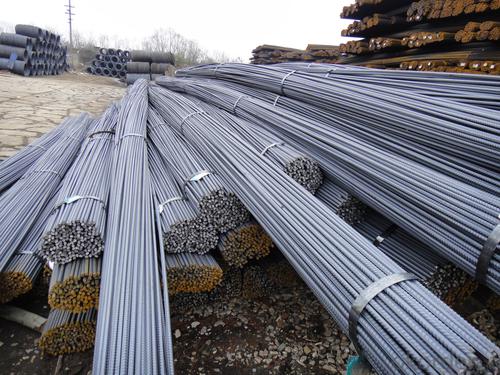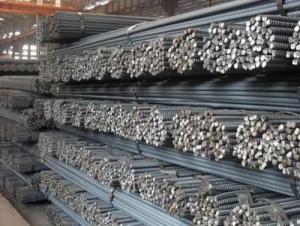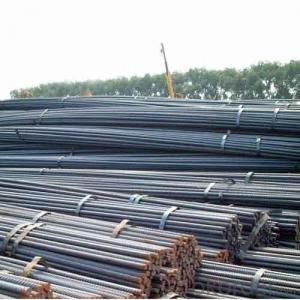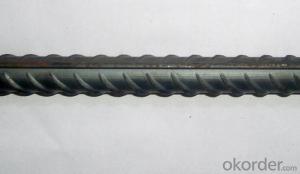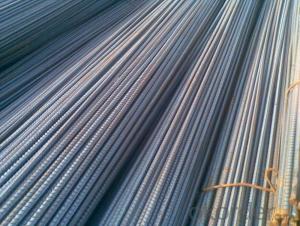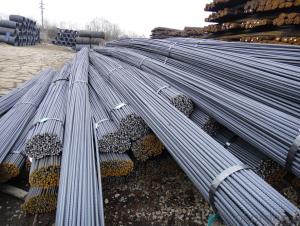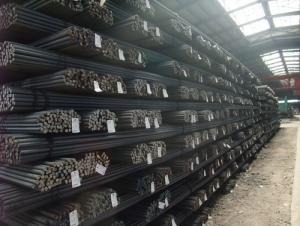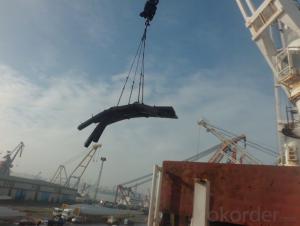Hot Rolled Carbon Steel Rebar 28mm with High Quality
- Loading Port:
- China Main Port
- Payment Terms:
- TT or LC
- Min Order Qty:
- 25 m.t.
- Supply Capability:
- 10000 m.t./month
OKorder Service Pledge
OKorder Financial Service
You Might Also Like
Product Description:
OKorder is offering Hot Rolled Carbon Steel Rebar 28mm with High Quality at great prices with worldwide shipping. Our supplier is a world-class manufacturer of steel, with our products utilized the world over. OKorder annually supplies products to European, North American and Asian markets. We provide quotations within 24 hours of receiving an inquiry and guarantee competitive prices.
Product Applications:
Hot Rolled Carbon Steel Rebar 28mm with High Quality is widely used in buildings, bridges, roads and other engineering construction. Big to highways, railways, bridges, culverts, tunnels, public facilities such as flood control, dam, small to housing construction, beam, column, wall and the foundation of the plate, deformed bar is an integral structure material. With the development of world economy and the vigorous development of infrastructure construction, real estate, the demand for deformed bar will be larger and larger..
Product Advantages:
OKorder's Hot Rolled Carbon Steel Rebar 28mm with High Quality are durable, strong.packed and suitable for construction
Main Product Features:
· Premium quality
· Prompt delivery & seaworthy packing (30 days after receiving deposit)
· Can be recycled and reused
· Mill test certification
· Professional Service
· Competitive pricing
Product Specifications:
Manufacture: Hot rolled
Grade: HRB335 HRB400 BS4449 Grade460 ASTM Grade40 Grade60
Certificates: ISO, SGS, BV, CIQ
Length:6m 8m 9m 12m
Packaging: Export packing, packed by coil
FAQ:
Q1: Why buy Materials & Equipment from OKorder.com?
A1: All products offered byOKorder.com are carefully selected from China's most reliable manufacturing enterprises. Through its ISO certifications, OKorder.com adheres to the highest standards and a commitment to supply chain safety and customer satisfaction.
Q2: How do we guarantee the quality of our products?
A2: We have established an advanced quality management system which conducts strict quality tests at every step, from raw materials to the final product. At the same time, we provide extensive follow-up service assurances as required.
Q3: How soon can we receive the product after purchase?
A3: Within three days of placing an order, we will begin production. The specific shipping date is dependent upon international and government factors, but is typically 7 to 10 workdays.
Q4: How many tons per bundle?
A4: Around 2-3tons
Q5: How to avoid the rust after deliver the goods to the loading port?
A5: We will keep the goods at the port covered with water-proof material
Q6: What is the chemical composition and physical properties of HRB400?
A6:
Grade | Technical data of the original chemical composition (%) | ||||||
C | Mn | Si | S | P | V | ||
HRB400 | ≤0.25 | ≤1.60 | ≤0.80 | ≤0.045 | ≤0.045 | 0.04-0.12 | |
Physical capability | |||||||
Yield Strength (N/cm²) | Tensile Strength (N/cm²) | Elongation (%) | |||||
≥400 | ≥570 | ≥14 | |||||
Images:

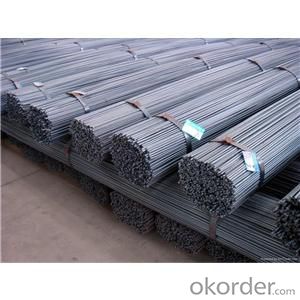
- Q: Are there any limitations on the maximum number of steel rebars that can be used in a concrete element?
- Yes, there are limitations on the maximum number of steel rebars that can be used in a concrete element. The limitations are typically determined by factors such as the size and shape of the concrete element, the design requirements, and the structural engineering standards and codes. Exceeding these limitations can lead to structural issues such as excessive cracking or failure of the concrete element. Therefore, it is important to adhere to the specified limitations to ensure the structural integrity and safety of the concrete element.
- Q: Are there any safety concerns related to handling steel rebars?
- Handling steel rebars comes with safety concerns. Not only are steel rebars heavy, but they can also strain muscles if not lifted correctly. To avoid injury, it is important to use appropriate lifting techniques and equipment, including gloves, back supports, and lifting tools. Furthermore, the sharp edges of rebars can puncture or lacerate, making it vital to wear protective clothing like steel-toed boots and gloves. Tripping hazards are also a concern when rebars are scattered on the ground. Keeping the work area clear and practicing good housekeeping can mitigate accidents. Lastly, power tools like cutting saws are commonly used when working with rebars. These tools generate noise, dust, and debris, so it is essential to wear protective gear such as hearing protection, dust masks, and eye protection. In conclusion, adhering to safety guidelines and proper procedures is imperative when handling steel rebars to prevent accidents and injuries.
- Q: Can steel rebars be used in concrete columns?
- Yes, steel rebars can be used in concrete columns. Rebars are commonly used to reinforce and strengthen concrete structures, including columns, due to their high tensile strength. The steel rebars are embedded within the concrete, providing additional support and preventing cracks or structural failures.
- Q: How do steel rebars affect the overall fire safety of a structure?
- The overall fire safety of a structure can be affected both positively and negatively by steel rebars. On the positive side, steel rebars contribute to the strength and stability of the structure, enabling it to withstand the impact of a fire and prevent collapse. This is particularly important for high-rise buildings or structures at risk of fire hazards. Moreover, steel rebars have a high melting point, making them more resistant to heat compared to other building materials. This characteristic slows down the spread of fire and allows for additional time for evacuation or firefighting efforts. However, there are also negative effects of steel rebars on fire safety. Exposed to high temperatures, steel expands, leading to structural deformations and potential failure of the rebars. This compromises the integrity of the structure and increases the risk of collapse. Furthermore, steel rebars conduct heat, transferring it from the fire to other parts of the structure. This localized heating weakens nearby materials and can accelerate the spread of fire within the building. To address these negative effects, fire-resistant coatings or fireproofing materials can be applied to the steel rebars. These coatings insulate and protect the rebars from high temperatures, delaying their failure and reducing the risk of collapse. In conclusion, while steel rebars enhance the overall fire safety of a structure through their strength and stability, they also come with drawbacks. Implementing appropriate fire protection measures, such as fire-resistant coatings, is vital to ensure optimal performance of the rebars during a fire.
- Q: Can steel rebars be used in dam construction projects?
- Yes, steel rebars can definitely be used in dam construction projects. Steel rebars are commonly used in the construction industry for reinforcing concrete structures, and dams are no exception. The rebars are embedded into the concrete to enhance its tensile strength, making it more resistant to cracking and structural failure. Dams, which are massive structures designed to hold back water, require a high level of strength and durability to withstand the immense forces and pressures exerted by the water. Steel rebars provide the necessary reinforcement to ensure the structural integrity of the dam. Additionally, steel rebars are corrosion-resistant, which is crucial in dam construction, where exposure to water is constant. Overall, the use of steel rebars in dam construction projects is a well-established and essential practice.
- Q: What is the difference between the actual weight and the actual weight of the steel thread?
- The actual weight is weighed and weight is calculated according to the theory of diameter *0.00617*M* diameter * * the number of root number general weight were weighed weight greater than you look at this with the giant is even large or small factory of some difference.
- Q: Can steel rebars be used in the construction of residential communities?
- Yes, steel rebars can be used in the construction of residential communities. Steel rebars are commonly used in the construction industry for reinforcing concrete structures, including residential buildings. They provide strength and durability to the concrete, improving its load-bearing capacity and resistance to cracks and other forms of structural damage. Steel rebars are often used in residential construction to reinforce foundation footings, walls, columns, and beams. They help to ensure the structural integrity of the building, making it safer and longer-lasting. Additionally, steel rebars can be easily customized and shaped to fit specific design requirements, allowing for flexibility in construction. Overall, the use of steel rebars in residential communities is a common and widely accepted practice in the construction industry.
- Q: Can steel rebars be used in marine construction?
- Yes, steel rebars can be used in marine construction. However, it is important to use corrosion-resistant steel rebars or apply protective coatings to prevent corrosion caused by exposure to saltwater and other harsh marine environments.
- Q: How do steel rebars affect the shrinkage and creep behavior of concrete?
- Steel rebars can significantly affect the shrinkage and creep behavior of concrete by providing reinforcement and reducing the overall cracking potential. The presence of rebars helps to distribute the tensile stress induced during drying shrinkage, thereby minimizing the development of cracks. Additionally, rebars can restrain the movement of concrete, reducing the creep deformation and improving the long-term stability of the structure.
- Q: How do steel rebars resist seismic forces?
- Steel rebars resist seismic forces in several ways. Firstly, their high tensile strength allows them to withstand the intense forces generated during an earthquake. Additionally, rebars are embedded within concrete structures, providing reinforcement and increasing the overall strength and stability of the building. The ductility of steel rebars also plays a crucial role as they have the ability to deform and absorb energy during seismic events, which helps prevent sudden collapse. Overall, the combination of strength, reinforcement, and ductility makes steel rebars an effective solution for resisting seismic forces and ensuring the safety of structures during earthquakes.
Send your message to us
Hot Rolled Carbon Steel Rebar 28mm with High Quality
- Loading Port:
- China Main Port
- Payment Terms:
- TT or LC
- Min Order Qty:
- 25 m.t.
- Supply Capability:
- 10000 m.t./month
OKorder Service Pledge
OKorder Financial Service
Similar products
Hot products
Hot Searches
Related keywords



